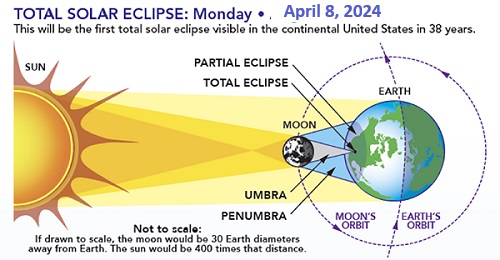 Watch
the Solar Eclipse
- Make Your Own Pinhole Camera for Next to Nothing!
Watch
the Solar Eclipse
- Make Your Own Pinhole Camera for Next to Nothing!Click here to Print this page as a PDF without any advertisements
Most people realize that the sun pumps out a lot of radiation and looking directly at it can damage your eyes and vision. But NASA tells us that for a brief total phase of a solar eclipse (the "totality" phase), when the moon entirely blocks the sun's bright face you can look at the eclipse for that 2 minute duration. But it's crucial to know when to take off and put back on your glasses. And "totality" will happen only within the narrow path of totality (see the map at right or on this page)
The diagram below shows the safe and dangerous zones based upon how far from the center path of the total eclipse you are.
Basically, NASA is saying that if you are in the total eclipse path,
the moon blocks out the harmful rays during the 2 minutes or
so of the complete eclipse. But outside of that area or before
or after the moon passes completely in front of the sun; you DO NEED
THE SPECIAL GLASSES. In theory, for those in the 70-mile band of
total eclipse, the moon will completely block the sun's rays, but as
long as a sliver of sun is still exposed, such as when the moon is
moving in front of the sun, or if you are not dead center, you could
still damage your eyes. This means most people will need the special glasses, and even those in the total eclipse zone should for
safety's sake. Here's what NASA says:
glasses, and even those in the total eclipse zone should for
safety's sake. Here's what NASA says:
Do not attempt to observe the partial or annular phases of any eclipse with the naked eye. Failure to use appropriate filtration may result in permanent eye damage or blindness!
This NASA page explains the how and why of when you can look at the sun without glasses in detail. See this page to see the path of the total eclipse.
A pinhole camera (a.k.a., a camera obscura ) is simple and inexpensive to make in a few minutes.
Here's all you need:
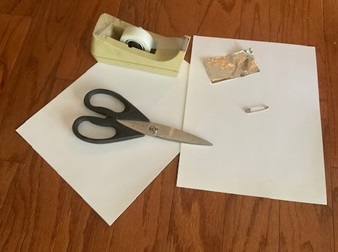
You'll need:
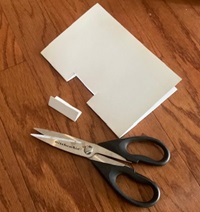
Cut a square or rectangular hole, 1-inch to 2-inches, in the center of the pieces of cardboard or stiff paper.
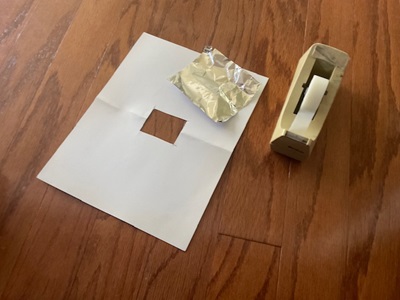
Cut the aluminum foil to an inch or 2 bigger in both dimensions (like 4 inches by 4 inches) that the hole and tape it on the cardboard over the
hole.

Flip the cardboard over, so the side with the aluminum foil and tape is facing down, and place the cardboard on another piece of cardboard. Poke ONE hole with your pushpin or safety pin right in the center of the aluminum foil.
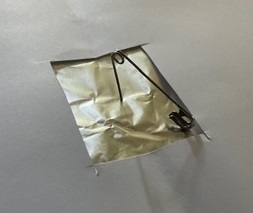

Solar retinopathy is the name for the disorder that happens when the sun's rays damage or destroy the photoreceptors that in your retina The retina is the back of the inside of your eyeball that takes the light collected by the lens and changes it to electrical impulses. Photoreceptors convert light into the electrical signals which are then sent by nerve cells to the optic nerve and the brain. If they are damaged by the sun, they may take 3-6 months to recover... or never recover or grow back. Lose enough photoreceptors and you go blind.
Homemade filters or ordinary sunglasses, even very dark ones, are not safe for looking at the sun; they transmit thousands of times too much sunlight. You eyes can and will be damaged without you even feeling it nor realizing it until later. Thin k of it like a sunburn. You don't realize your skin is getting burned until it is already damaged and turns red. But eyes do not recover from this damage!
A solar eclipse is one of nature's grandest spectacles. By following these simple rules, you can safely enjoy the view and be rewarded with memories to last a lifetime. More information:
eclipse.aas.org eclipse2017.nasa.gov
This document does not constitute medical advice. Readers with questions should contact a qualified eye-care professional.
This page has many fun local events along the path, using Google maps.
An eclipse is a rare and striking phenomenon you won't want to miss, but you must carefully follow safety procedures. Don't let the requisite warnings scare you away from witnessing this singular spectacle! You can experience the eclipse safely, but it is vital that you protect your eyes at all times with the proper solar filters. No matter what recommended technique you use, do not stare continuously at the sun. Take breaks and give your eyes a rest! Do not use sunglasses: they don't offer your eyes sufficient protection. The only acceptable glasses are safe viewers designed for looking at the sun and solar eclipses. One excellent resource on how to determine if your viewers are safe can be found here: https://eclipse.aas.org/eye-safety/iso-certification
Viewing with Protection -- Experts suggests that one widely available filter for safe solar viewing is welders glass of sufficiently high number. The only ones that are safe for direct viewing of the Sun with your eyes are those of Shade 12 or higher. These are much darker than the filters used for most kinds of welding. If you have an old welder's helmet around the house and are thinking of using it to view the Sun, make sure you know the filter's shade number. If it's less than 12 (and it probably is), don't even think about using it to look at the Sun. Many people find the Sun too bright even in a Shade 12 filter, and some find the Sun too dim in a Shade 14 filter - but Shade 13 filters are uncommon and can be hard to find. The AAS Reputable Vendors of Solar Filters & Viewers page doesn't list any suppliers of welder's filters, only suppliers of special-purpose filters made for viewing the Sun. To find out more about eyewear and handheld viewers go to https://eclipse.aas.org/eye-safety/eyewear-viewers.
Telescopes with Solar Filters - Eclipses are best viewed directly when magnified, which means a telescope with a solar filter or solar telescopes. These will give you a magnified view that will clearly show the progress of an eclipse. Never look through a telescope without a solar filter on the large end of the scope. And never use small solar filters that attach to the eyepiece (as found in some older, cheaper telescopes.) https://eclipse.aas.org/eye-safety/optics-filters
Other Related Projection Methods -- Pinhole projectors and other projection techniques are a safe, indirect viewing technique for observing an image of the sun. These provide a popular way for viewing solar eclipses. One viewing technique is to project an image of the sun onto a white surface with a projecting telescope. This is explained further here: http://www.astrosociety.org/education/publications/tnl/05/stars2.html
The Exploratorium demonstrates how to view a planet in transit or an eclipse safely by projecting the image with binoculars:http://www.exploratorium.edu/transit/how.html. There are commercially available projection telescopes as well.
Besides eye protection during solar eclipse viewing, one needs to pay attention to their personal needs and surrounding. Below are some additional safety tips for eclipse observers before, during and after the August 21, 2017 solar eclipse.
Refer to the American Astronomical Society (AAS) Reputable Vendors of Solar Filters & Viewers page (see it below)for a list of manufacturers and authorized dealers of eclipse glasses and handheld solar viewers verified to be compliant with the ISO 12312-2 international safety standard for such products.
Ways to save money AND help the environment:
Eat healthier AND save money: Instant Pot Duo Crisp 11-in-1 Air Fryer and Electric Pressure Cooker Combo with Multicooker Lids that Fries, Steams, Slow Cooks, Sautés, Dehydrates
Save water AND money with this showerhead adapter, it lets the water flow until the water is hot, then shuts off water flow until you restart it, ShowerStart TSV Hot Water Standby Adapter
Protect your health with these:
Mattress Dust mite-Bedbug protector, 100% Waterproof, Hypoallergenic, Zippered
Handheld Allergen Vacuum Cleaner with UV Sanitizing and Heating for Allergies and Pet, Kills Mite, Virus, Molds, True HEPA with Powerful Suction removes Hair, Dander, Pollen, Dust,
Immune Support Supplement with Quercetin, Vitamin C, Zinc, Vitamin D3
GermGuardian Air Purifier with UV-C Light and HEPA 13 Filter, Removes 99.97% of Pollutants
5 Stage Air Purifier, Features Ultraviolet Light (UVC), H13 True Hepa, Carbon, PCO, Smart Wifi, Auto Mode, Quiet, Removes 99.97% of Particles, Smoke, Mold, Pet Dander, Dust, Odors
Interesting Reads:
THE PREPPER'S CANNING & PRESERVING BIBLE: [13 in 1] Your Path to Food Self-Sufficiency. Canning, Dehydrating, Fermenting, Pickling & More, Plus The Food Preservation Calendar for a Sustainable Pantry
The Backyard Homestead: Produce all the food you need on just a quarter acre! Paperback
The Citizens' Guide to Geologic Hazards: A Guide to Understanding Geologic Hazards Including Asbestos, Radon, Swelling Soils, Earthquakes, Volcanoes
The Uninhabitable Earth: Life After Warming
Book: The Sixth Extinction: An Unnatural History Paperback